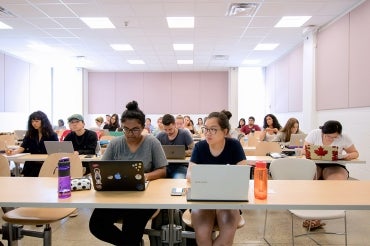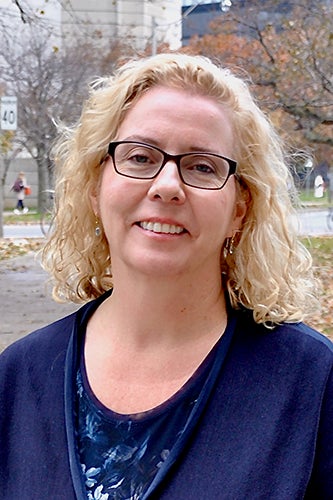U of T researcher’s active-learning app bridges gap between students and instructors

Published: February 3, 2020
A class of 1,500 students in the University of Toronto’s Convocation Hall presents a number of challenges for instructors.
How do you make lectures engaging and interactive? How do you know if students understand a concept and are ready to move on to the next? How do you get students to learn together?
 To cope with these challenges, Melody Neumann, an associate professor, teaching stream in the department of cell and systems biology in the Faculty of Arts & Science, developed an active-learning tool called Team Up! that was made available to classes across the university earlier this year.
To cope with these challenges, Melody Neumann, an associate professor, teaching stream in the department of cell and systems biology in the Faculty of Arts & Science, developed an active-learning tool called Team Up! that was made available to classes across the university earlier this year.
The secure browser-based app,which works on a phone, iPad or laptop, allows students to work together on problems in real time while providing immediate feedback to both instructors and students. The software, supported by U of T’s learning management system Quercus, also enables partial marks for approximate answers and is free to use, unlike classroom response tools such as Top Hat.
Team Up! is not just for Con Hall-sized classes, but for any class – including online – where the opportunity for interaction between instructors and students is limited.
Neumann’s research focuses on many aspects of undergraduate teaching, including the development of innovative and evidence-based practices.
“I love teaching,” Neumann says. “I love empowering students. I've always been interested in using technology to teach and technology has now advanced to the point where Team Up! is possible.
“Plus, it’s based on evidence that shows us the best way to teach.”
Megan Frederickson, an associate professor in the department of ecology and evolutionary biology, uses Team Up! in her adaptation and biodiversity (BIO120) course, which she teaches in Convocation Hall to more than 1,700 students.
“Team Up! helps make a big course like BIO120 more interactive,” says Frederickson, “especially because it allows students to answer questions about the lecture material in small groups, in real time. This is a great way to learn new concepts.”
Brian Wilson is a sessional lecturer in the department of physics who has used Team Up! in two different courses.
“With Team Up!, I take a standard physics problem and break it down into three to five steps,” says Wilson. “Each of these is its own question, which students keep working on until they get it correct. That means they learn what they need to before going on to the next step. They work in groups for 10 to 15 minutes while I walk around and help anyone who still needs help.”
Even in a class with hundreds of students, Team Up! lets instructors know how their students are doing.
“It helps me understand what aspects of the lecture material are clear and what aspects students are still confused about,” says Frederickson.
“In a large classroom, getting audience feedback about whether something we discussed makes sense is a challenge,” says Wilson. “Any audience response system helps with this, but Team Up! is better because students instantly find out if they’re wrong and have an opportunity for discussion with each other before trying a second time.”
“Also, the default is that they work in teams. And the team gets to give only one answer, so they should be trying to convince each other that they are correct. This helps foster active, peer-based learning.”
The app has also garnered praise from the wider academic community. In 2016, Team Up! won the annual IMS Global Learning Consortium’s Connected Learning Innovation App Challenge. More recently, it placed second in the e-Learning Excellence Awards at the 18th European Conference on e-Learning in Copenhagen.
Neumann developed Team Up! with the help of her faculty partners, Michelle French, an associate professor, teaching stream, in the Faculty of Medicine’s department of physiology, and Franco Taverna, an associate professor, teaching stream, in the human biology program.
The collaboration also included U of T’s Academic & Collaborative Technologies (ACT), Online Learning Strategies (OLS) and Information Technology Services (ITS).
Team Up! was used in 10 courses by some 6,000 students in 2018-2019 before being rolled out university-wide.
Now, Neumann is looking to enhance Team Up! by adding further functionality and encouraging more of her colleagues to adopt it.
“It's important that these homegrown tools continue to evolve and I’m looking forward to seeing people use it in ways that I never expected,” she says.



